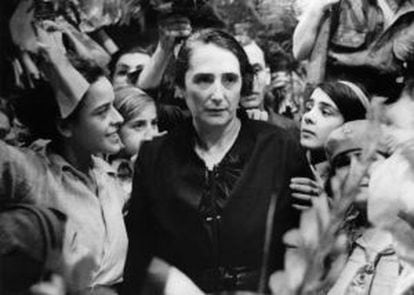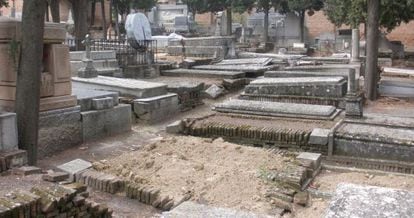Enemies in life, neighbors in death
A Nazi general’s grave lies next to those of socialists and communists in a Madrid cemetery

A stroll down Madrid’s graveyards can yield a few surprises. The casual observer will be amazed to see how the border lines that exist in life are blurred by death. This is what happened to Andrés, a university professor who went to Madrid’s Cementerio Civil (Civil Cemetery) to pay a visit to his grandfather José’s grave.
Located inside the same necropolis that houses La Almudena cemetery, the area known as Cementerio Civil was created in the 1880s as a burial site for people who were not born Catholic or who had rejected the Catholic faith.
After passing by the resting place of Dolores Ibárruri (1895-1989), better known as the Pasionaria and one of the most famous female Communist leaders of the 20th century, Andrés also took note of the pink granite mausoleum containing the remains of Pablo Iglesias Posse (1850-1925), a pioneer of the Spanish socialist movement.
But then, Andrés noticed a large tombstone around 30 meters from the two above-mentioned graves, and practically across from the mausoleums where two historic figures of the First Spanish Republic lie buried, Francesc Pi i Margall and Nicolás Salmerón.
This particular headstone had the following inscription:“Johannes E.F. Bernhardt, 1/I/1898-13/II/1980”. Next to it, other gravestones showed a man’s and a woman’s name, also German-sounding, and presumably relatives of the former.
At first, Andrés thought this must be some illustrious German – an atheist, a protestant or a progressive – who had asked to be buried at the cemetery of choice for many people of Republican, socialist and communist convictions, as well as agnostics and secular thinkers in general, who were all laid to rest in this segregated section of the necropolis.
But soon thereafter Andrés realized that the individual buried there had nothing to do, ideologically speaking, with his graveyard neighbors.

Johannes E. F. Bernhardt was a financial mastermind for Nazi Germany and an active regime agent in Madrid. He coordinated the shipments of military and financial supplies to the future dictator Francisco Franco months before the Spanish Civil War broke out, in July 1936. Later, he also exploited Spain’s natural resources for the benefit of the German war effort.
A Bavarian by birth, Bernhardt fought in World War I, then joined the Nazi party and cultivated relationships with its key leaders, most notably Hermann Göring, a flying ace who would later become the number-two man in the Third Reich.
Franco and Bernhardt first made contact over aircraft issues, at a time when the latter was doing business out of North Africa, where Franco had pursued his military career.
It was in Morocco that Franco asked the Nazi financier for German planes to take Spanish troops from the protectorate to the peninsula as backup for his coup plot – a petition that Bernhardt honored after first consulting with Hitler.
A squadron of 20 Juncker-52’s escorted by Heinkel aircraft flew to Morocco. This fleet allowed Franco to transfer thousands of legionarios (an elite unit modeled after the French Légion) to the mainland, where they quickly took the southern city of Seville. From there, Franco’s troops advanced north and center.
Bernhardt was a financial mastermind for Nazi Germany and an active regime agent in Madrid
Bernahrdt gradually became the main exploiter of Spanish resources for Germany, controlling the shipments of valuable tungsten from Zamora, Salamanca and Galicia, and pyrite from Huelva. At the same time, he was the leading supplier of German spare parts to Franco.
His business was conducted through two companies, Hisma and Rowak, and through the Transatlantic Commercial Bank, located inside the same palace that now houses the Thyssen-Bornemisza art museum.
Bernhardt went on to become an honorary general of the SS, and built himself a lovely villa in the Mediterranean resort of Denia. His Madrid residence was a detached house surrounded by a garden brimming with plants in the elegant district of Arturo Soria.
But when WWII ended, the Allies began calling for Bernhardt’s head as a key supplier and collaborator of the Nazi regime. Franco resisted, and rumor has it that the Spanish dictator – an ally of Hitler and Mussolini – even gave Bernhardt a valuable 17th-century oil painting currently held by the Prado Museum, as a token of gratitude for all his services.
Eventually, however, Franco suggested that the the honorary Nazi general might do well to flee to Argentina, where many fellow military men like himself found refuge under Colonel Juan Domingo Perón. This was in 1950. In the three decades that followed, Bernhardt shuttled between Argentina and his Mediterranean refuge in Denia.

While he did not like to be seen around, Bernhardt did benefit from a decision made by the Allies, especially the Americans, to use some former members of the Nazi party and secret services in the fight against the spread of communism in Europe.
Scholars who have studied the life of Johannes E.F. Bernhardt cannot agree on the place of his death. Some say he passed away in the southern German city of Munich in 1980; others assert that he died in Argentina; the gravestone found by the university professor Andrés seems to suggest that death found him in Madrid.
Yet the records at Madrid’s Cementerio Civil do not show that his body was ever buried there. So where is he buried then? Is this gravestone a family memento or a trick to cover his tracks?
Whatever the case, the tombstone is located in the same cemetery and not 30 meters away from the resting place of people who stood for the ideological and political antithesis of what Bernhardt represented: socialism and communism versus Nazism, a battle that defined much of the history of the 20th century.
And this is not the only surprise to be found at this cemetery. A mere 100 steps from the Nazi general’s tombstone, over a brick wall, there is a secluded spot that is home to a Jewish cemetery.










































